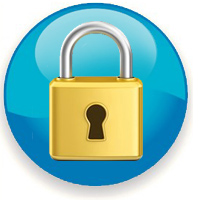
Evolution of Digital Rights Management
 Digital
Rights Management (DRM) has been around for a while, but not for as long
as what some want us to believe. The information provided by
Wikipedia on DRM has grown exponentially over the years while anyone
who has ever researched, developed or even written about it since
has added a link for themselves. Such is the creditability of that
information resource when it can be edited by anyone. I have seen many
entities added who appeared well after the
reference to which they appended.
Digital
Rights Management (DRM) has been around for a while, but not for as long
as what some want us to believe. The information provided by
Wikipedia on DRM has grown exponentially over the years while anyone
who has ever researched, developed or even written about it since
has added a link for themselves. Such is the creditability of that
information resource when it can be edited by anyone. I have seen many
entities added who appeared well after the
reference to which they appended.
It wasn't until 2000 that DRM became a buzz word and bantied around by
some in the copy protection industry whether they employed DRM or
not. Digital Rights Management or Document Rights Management was
about controlling access to media, and not just with a password, but
ensuring that the media could not be shared. Passwords can be shared
and there is nothing in place to prevent that. DRM is really about
restricting access to the media to intended users only, thus
preventing distribution without authority.
All sorts of methods for preventing copy and redistribution was
falsely advertised as DRM and "best copy protection" most were
really as secure as a soggy paper bag, encrypted
images that could be saved from their web page and displayed on any
other web site, media packed in a compressed file (ZIP)
requiring a password or affected by expiry date. In all of these
cases, once the media was on display or unpacked (unzipped), there was nothing in place to
prevent their copy and redistribution. Yet their vendors claimed
them to be "DRM protected".
 Consequently DRM got a bad name and became the sport of authors
writing about "how easy it is to remove DRM" and software developers
creating software to remove protection from all sorts of files. And
yes that was very true in the case of the DRM applied to Adobe PDF.
So with so much DRM being easily exploited, it was most difficult
for those in the industry that were successfully protecting media to
justify their existence.
Consequently DRM got a bad name and became the sport of authors
writing about "how easy it is to remove DRM" and software developers
creating software to remove protection from all sorts of files. And
yes that was very true in the case of the DRM applied to Adobe PDF.
So with so much DRM being easily exploited, it was most difficult
for those in the industry that were successfully protecting media to
justify their existence.
Where did all of these DRM solutions come from? Well it may have
been due to the hype promoted by some of the early
startups in the copy protection industry to encourage
investors and attract public funding. They were promoting copy
protection as a multi-million dollar business by citing the value of
lost revenue due to the copy and unauthorized distribution of movies
and other media. When one does the sums and counts the revenue lost
to piracy it seems equitable for those media companies to pay a
percentage of that lost revenue for protection to prevent such
losses. Well the spiel worked and I recall the aooearance of 2 new startups,
each commencing with 20 plus million dollars. That funding was later
increased but to no avail because their product was over rated and
flawed. While they were not more than imitations of ArtistScope
solutions they were extremely expensive.
 Whether
they believed their own hype or not is not important, but what
everyone soon discovered was that "copy protection" is not a
multi-million dollar business no matter how you wrap it. Those two
startups disappeared within 2-3 years and their investors kissed
their hard earned savings good-bye.
Whether
they believed their own hype or not is not important, but what
everyone soon discovered was that "copy protection" is not a
multi-million dollar business no matter how you wrap it. Those two
startups disappeared within 2-3 years and their investors kissed
their hard earned savings good-bye.
DRM has lived on and new startups still appear. Only last year another one
with $12 million funding went to the cleaners. Their product was a
web browser designed for data security with malware protection and
intended for use in corporate networks. A lot was spent on promoting
that browser and to someone who understands how copy
protection and security work, it be obvious that they employed the
best wordsmiths because reading their brochure was
like visiting Alice in Wonderland where nothing is real.
But there are many companies still researching and developing ways
to protect
video and other media. The big target is the film industry because that
is where millions are spent to create movies and that is where
almost the entire population seems to be hell bent on pirating and
viewing for free. So you have the media industry sitting on one side of the
fence while on the other side you have the public and the anti-DRM lobbyists doing
anything that they can to undermine DRM.
DRM protects the livelihood of those creating the media. All they
want is to be paid for the work that they do. Yet the public, who
are happy to be paid for their own work and to be able to feed their
own family, have a hunger for free video that deprives the film
industry
from feeding their families. But it is not just the film industry
that suffers because the same adversity is encountered by the
distributors of all types of media.
What is the future of DRM for video? That depends on the target
market. Video for home entertainment, like the video that you hire
and play on your TV recorder, is impossible to protect indefinitely. That is
a market where millions has been spent on research and development
to protect but its success is a catch 22 because for it to be 100%
unexploitable, proprietary hardware (video player) is
required and even that would not be safe for too long, unless there
is a way to prevent the anti-DRM mindset from
distributing similar hardware that counters the protection.
 That is the state of affairs on that front, but on computers,
especially on Windows computers, DRM can be most secure. However any
DRM solution that is expected to be supported on all other OS will
be doomed to failure because those OS are not as secure and in
comparison, can be considered unstable. For example the Windows
operating system (OS) doesn't change much and even radical changes
like the upgrade from Windows 8 to Windows 10 took several years.
What that means in terms of stability is that any software designed
to run on a Windows OS will be good for several years and will most
likely run on the next version as well. But that is not so with the
other OS. In relation to system integrity non-Windows OS, especially
those used in amusement devices like mobile phones, are vulnerable
to exploit, which is why the apps for them are simple add-ons that
are based on JavaScript and HTML. As such they cannot do any harm to
the operating system. But then, by not being able to operate at
system level, the add-ons are ineffective in preventing copy or
preventing other apps from exploiting media.
That is the state of affairs on that front, but on computers,
especially on Windows computers, DRM can be most secure. However any
DRM solution that is expected to be supported on all other OS will
be doomed to failure because those OS are not as secure and in
comparison, can be considered unstable. For example the Windows
operating system (OS) doesn't change much and even radical changes
like the upgrade from Windows 8 to Windows 10 took several years.
What that means in terms of stability is that any software designed
to run on a Windows OS will be good for several years and will most
likely run on the next version as well. But that is not so with the
other OS. In relation to system integrity non-Windows OS, especially
those used in amusement devices like mobile phones, are vulnerable
to exploit, which is why the apps for them are simple add-ons that
are based on JavaScript and HTML. As such they cannot do any harm to
the operating system. But then, by not being able to operate at
system level, the add-ons are ineffective in preventing copy or
preventing other apps from exploiting media.
That is why ArtistScope, the founder and leading developer of copy
protection for more than 20 years, provides DRM and copy protection
solutions for Windows only. In other words, why lock the doors if
you are going to leave the windows open?
Author: William Kent
Date: 16th July 2019
Return to DRM and Copy Protection
Comments
| iCartoon |
2019-07-19 |
|
Yes, I recall a time when DRM meant high-tech access rights control. But now it
has lost its relevance thanks to the nonsense spread about DRM being easily
removed plus the scores of fake protection services using the term "DRM" to
sensationalize their droppings. |
| Ian Snow |
2019-07-22 |
|
Cheer up William. I too have seen a lot of new startups barge into the copy protection industry with huge funding to smother PR and Adwords with
their wonderful [sic] solutions. But I haven't seen anything new or worthwhile and yes, they do seem to fade away after a couple of years.
Nothing like CopySafe that we have found dependable and most effective. Keep up
the good work! |

 Digital
Rights Management (DRM) has been around for a while, but not for as long
as what some want us to believe. The information provided by
Wikipedia on DRM has grown exponentially over the years while anyone
who has ever researched, developed or even written about it since
has added a link for themselves. Such is the creditability of that
information resource when it can be edited by anyone. I have seen many
entities added who appeared well after the
reference to which they appended.
Digital
Rights Management (DRM) has been around for a while, but not for as long
as what some want us to believe. The information provided by
Wikipedia on DRM has grown exponentially over the years while anyone
who has ever researched, developed or even written about it since
has added a link for themselves. Such is the creditability of that
information resource when it can be edited by anyone. I have seen many
entities added who appeared well after the
reference to which they appended. Consequently DRM got a bad name and became the sport of authors
writing about "how easy it is to remove DRM" and software developers
creating software to remove protection from all sorts of files. And
yes that was very true in the case of the DRM applied to Adobe PDF.
So with so much DRM being easily exploited, it was most difficult
for those in the industry that were successfully protecting media to
justify their existence.
Consequently DRM got a bad name and became the sport of authors
writing about "how easy it is to remove DRM" and software developers
creating software to remove protection from all sorts of files. And
yes that was very true in the case of the DRM applied to Adobe PDF.
So with so much DRM being easily exploited, it was most difficult
for those in the industry that were successfully protecting media to
justify their existence. Whether
they believed their own hype or not is not important, but what
everyone soon discovered was that "copy protection" is not a
multi-million dollar business no matter how you wrap it. Those two
startups disappeared within 2-3 years and their investors kissed
their hard earned savings good-bye.
Whether
they believed their own hype or not is not important, but what
everyone soon discovered was that "copy protection" is not a
multi-million dollar business no matter how you wrap it. Those two
startups disappeared within 2-3 years and their investors kissed
their hard earned savings good-bye. That is the state of affairs on that front, but on computers,
especially on Windows computers, DRM can be most secure. However any
DRM solution that is expected to be supported on all other OS will
be doomed to failure because those OS are not as secure and in
comparison, can be considered unstable. For example the Windows
operating system (OS) doesn't change much and even radical changes
like the upgrade from Windows 8 to Windows 10 took several years.
What that means in terms of stability is that any software designed
to run on a Windows OS will be good for several years and will most
likely run on the next version as well. But that is not so with the
other OS. In relation to system integrity non-Windows OS, especially
those used in amusement devices like mobile phones, are vulnerable
to exploit, which is why the apps for them are simple add-ons that
are based on JavaScript and HTML. As such they cannot do any harm to
the operating system. But then, by not being able to operate at
system level, the add-ons are ineffective in preventing copy or
preventing other apps from exploiting media.
That is the state of affairs on that front, but on computers,
especially on Windows computers, DRM can be most secure. However any
DRM solution that is expected to be supported on all other OS will
be doomed to failure because those OS are not as secure and in
comparison, can be considered unstable. For example the Windows
operating system (OS) doesn't change much and even radical changes
like the upgrade from Windows 8 to Windows 10 took several years.
What that means in terms of stability is that any software designed
to run on a Windows OS will be good for several years and will most
likely run on the next version as well. But that is not so with the
other OS. In relation to system integrity non-Windows OS, especially
those used in amusement devices like mobile phones, are vulnerable
to exploit, which is why the apps for them are simple add-ons that
are based on JavaScript and HTML. As such they cannot do any harm to
the operating system. But then, by not being able to operate at
system level, the add-ons are ineffective in preventing copy or
preventing other apps from exploiting media.